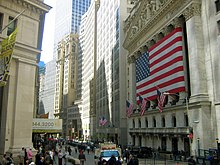In 12th century France the courratiers de change were concerned with managing and regulating the debts of agricultural communities on behalf of the banks. Because these men also traded with debts, they could be called the first brokers. A common misbelief is that in late 13th century Bruges commodity traders gathered inside the house of a man called Van der Beurze, and in 1309 they became the "Brugse Beurse", institutionalizing what had been, until then, an informal meeting, but actually, the family Van der Beurze had a building in Antwerp where those gatherings occurred;[6] the Van der Beurze had Antwerp, as most of the merchants of that period, as their primary place for trading. The idea quickly spread around Flanders and neighboring counties and "Beurzen" soon opened in Ghentand Amsterdam.
In the middle of the 13th century, Venetian bankers began to trade in government securities. In 1351 the Venetian government outlawed spreading rumors intended to lower the price of government funds. Bankers in Pisa, Verona, Genoa and Florence also began trading in government securities during the 14th century. This was only possible because these were independent city states not ruled by a duke but a council of influential citizens. The Dutch later started joint stock companies, which let shareholders invest in business ventures and get a share of their profits - or losses. In 1602, the Dutch East India Company issued the first share on theAmsterdam Stock Exchange. It was the first company to issue stocks and bonds.
The Amsterdam Stock Exchange (or Amsterdam Beurs) is also said to have been the first stock exchange to introduce continuous trade in the early 17th century. The Dutch "pioneered short selling, option trading, debt-equity swaps, merchant banking, unit trusts and other speculative instruments, much as we know them".[7]There are now stock markets in virtually every developed and most developing economies, with the world's biggest markets being in the United States, United Kingdom, Japan, India, China, Canada, Germany, France, South Korea and the Netherlands.[8]

